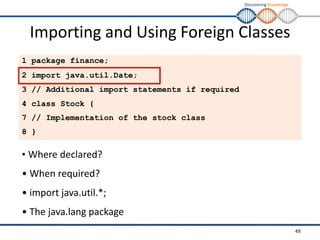The document discusses object-oriented programming concepts including objects, classes, message passing, abstraction, encapsulation, inheritance, polymorphism, and dynamic binding. It provides examples and definitions for each concept. It also discusses how to represent real-world entities like a person or place as objects with states (attributes and values) and behaviors (methods). Classes are defined as blueprints that specify common properties and functionality for objects. The relationships between classes and objects are demonstrated.






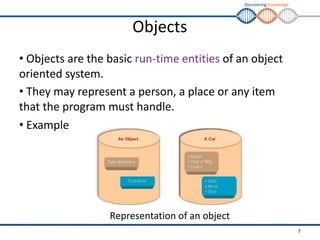







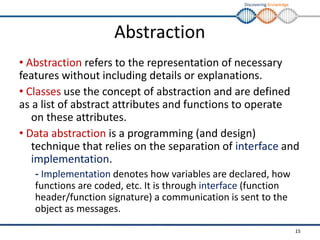



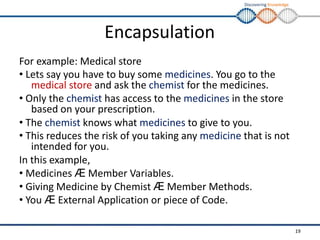



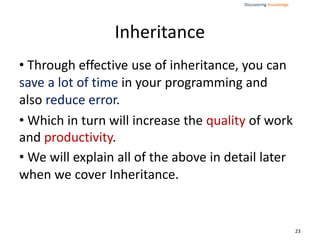




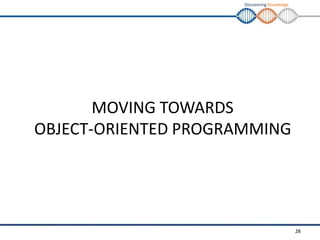
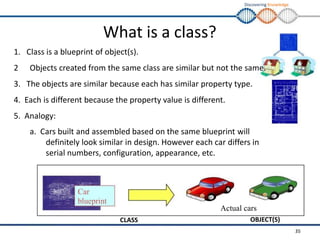
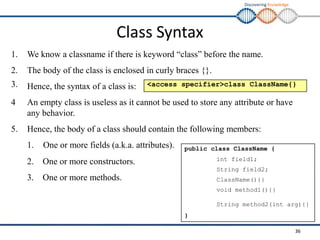

![public class Website {
String webName;
int webAge;
public static void main(String args[]){
//Creating objects
Website obj1 = new Website();
obj1.webName="Amazon";
obj1.webAge=4;
Website obj2 = new Website();
obj2.webName="Google";
obj2.webAge=14;
//Accessing object data through reference
System.out.println(obj1.webName+" "+obj1.webAge);
System.out.println(obj2.webName+" "+obj2.webAge);
}
}
Output:
Amazon 4
Google 14](https://image.slidesharecdn.com/03-fundamentalsofoop-180410172053-230824022145-8e42797f/85/80410172053-pdf-32-320.jpg)




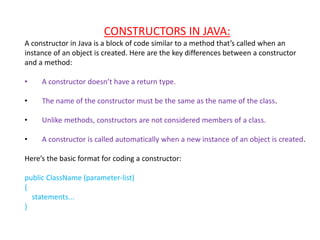


![For Example: Here passing argument to the constructor while calling it
public class Puppy {
public Puppy(String name) {
// This constructor has one parameter, name.
System.out.println("Passed Name is :" + name );
}
public static void main(String []args) {
// Following statement would create an object myPuppy
Puppy myPuppy = new Puppy( "tommy" );
}
} OUTPUT:
Passed Name is :tommy](https://image.slidesharecdn.com/03-fundamentalsofoop-180410172053-230824022145-8e42797f/85/80410172053-pdf-40-320.jpg)

![public static void main(String []args) {
/* Object creation , passing name to constructor*/
Puppy myPuppy = new Puppy( "tommy" );
/* Call class method to set puppy's age */
myPuppy.setAge( 2 );
/* Call another class method to get puppy's age */
myPuppy.getAge( );
/* You can access instance variable as follows as well */
System.out.println("Variable Value :" + myPuppy.puppyAge );
}
} OUTPUT:
Name chosen is :tommy
Puppy's age is :2
Variable Value :2](https://image.slidesharecdn.com/03-fundamentalsofoop-180410172053-230824022145-8e42797f/85/80410172053-pdf-42-320.jpg)


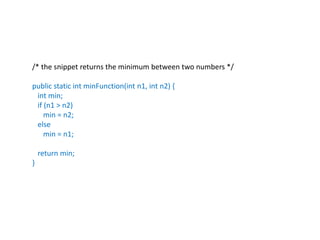



![Discovering Knowledge
Application Class
1. Application class is also known by other names
such as Driver , Test, Main or Launcher class.
2. Application class is a class that contains the
main method.
• public static void main(String [] args){}
3. Not every class will contain the main method.
4. If a program is made up of only one class, that
class definitely has to become the application
class.
5. If a program is made up of many classes, only
one of the classes need to be the application
class.
6 Application class will be the first class loaded
and executed.
ClassName
+main(String[] args):void
Example 1
Student
name: String
greet():void
+main(String[] args):void
Example 2
42](https://image.slidesharecdn.com/03-fundamentalsofoop-180410172053-230824022145-8e42797f/85/80410172053-pdf-49-320.jpg)

![Discovering Knowledge
Discussion: Class Members
class Country {
String name = “Pakistan";
public static void main(String[] args){
Country pakistan = new Country();
pakistan.greet();
}
void greet(){
System.out.println(“Welcome to " + name);
}
}
1. Describe what happens within the main method.
2. Describe what happens within the greet() method.
3. Is this programming object-oriented? How do you know?
44](https://image.slidesharecdn.com/03-fundamentalsofoop-180410172053-230824022145-8e42797f/85/80410172053-pdf-51-320.jpg)
![Discovering Knowledge
Discussion: Class Members
class Country {
String name = “Pakistan";
public static void main(String[] args){
Country pakistan = new Country();
pakistan.greet();
}
void greet(){
System.out.println(“Welcome to " + name);
}
}
This step creates an object called pakistan from Country class.
What does the object pakistan do?
45](https://image.slidesharecdn.com/03-fundamentalsofoop-180410172053-230824022145-8e42797f/85/80410172053-pdf-52-320.jpg)
![Discovering Knowledge
Discussion: Class Members
class Country {
String name = “Pakistan";
public static void main(String[] args){
Country pakistan = new Country ();
pakistan.greet();
}
void greet(){
System.out.println(“Welcome to " + name);
}
}
Can the method access the field’s value?
What is the output?
46](https://image.slidesharecdn.com/03-fundamentalsofoop-180410172053-230824022145-8e42797f/85/80410172053-pdf-53-320.jpg)


